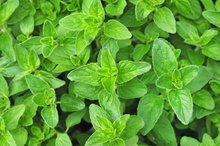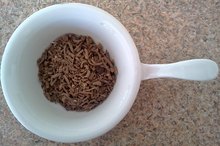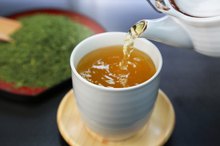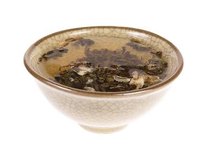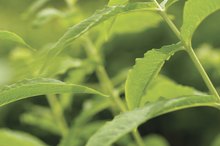Herbs for Estrogen Dominance
According to women’s health expert Christiane Northrup, M.D., estrogen dominance is defined as a syndrome caused by a hormonal imbalance leading to higher levels of estrogen relative to progesterone. Northrup notes that in the 10 to 15 years leading up to menopause, many women experience symptoms indicative of estrogen dominance. To decrease estrogen dominance, Northrup suggests the consumption of phytoestrogens to block excess estrogen production and the use of natural progesterone cream, to balance out the dominating effects of excess estrogen. Similar mechanisms of this action can be mimicked by herbs.
Herbs may have side effects and interactions with other medications and should only be taken in consultation with a health care professional.
Vitex Agnus Cactus
Vitex, commonly known as chasteberry, is an herb known for its hormone balancing effects. Vitex is able to lessen excessive estrogen levels by at least three mechanisms. Firstly, the 1998 article, “Black Cohosh and Chasteberry: Herbs Valued by Women for Centuries,” author Joseph Mayo, M.D., notes that the herb directly inhibits the production of follicle stimulating hormone, the pituitary hormone that directly stimulates the production of estrogen in the ovaries 1. Furthermore, the herb increases the production of luteinizing hormone, the brain hormone that allows for progesterone production within the ovaries. Lastly, by stimulating the production of the neurotransmitter dopamine in the body, chasteberry inhibits prolactin, a potent inhibitor of luteinizing hormone. By inhibiting prolactin, Vitex additionally adds to the progesterone increase and balances the dominating effects of estrogen.
- Vitex, commonly known as chasteberry, is an herb known for its hormone balancing effects.
- Firstly, the 1998 article, “Black Cohosh and Chasteberry: Herbs Valued by Women for Centuries,” author Joseph Mayo, M.D., notes that the herb directly inhibits the production of follicle stimulating hormone, the pituitary hormone that directly stimulates the production of estrogen in the ovaries 1.
Damiana
Sarsaparilla Root Side Effects
Learn More
According to the tropical plant database file on Damiana, adapted from the book “The Healing Power of Rainforest Herbs,” Damiana was studied in a 1998 in-vitro clinical trial and found to have anti-estrogenic or neutralizing effects because of its ability to bind to progesterone receptors on breast cancer cells. According to the database, researchers then surmised that the herb had a neutral or anti-estrogenic activity.
Licorice
Glycyrrhiza glabra, or licorice, has many effects in the body. Although commonly known for its distinctive flavor in teas and candies, the far reaching effects of licorice make it a strongly influential herbal medicine. According to Paul Bergner, author of the journal article “Glycyrrhiza: Licorice Root and Testosterone”, licorice has been shown to reduce circulating testosterone levels in studies of women with polycistic ovarian syndrome as well as in men and animal studies 4. Licorice is able to prolong the half-life of the hormone cortisol, which may be important in the treatment of adrenal fatigue and exhaustion. Furthermore, Bergner expresses that in a trial of licorice over a 7-day period, in addition to lowering testosterone levels, glycyrrhiza was also able to increase production of progesterone in the form of 17-hydroxy-progesterone 4.
Red Clover
How Does Licorice Root Help Lower Libido?
Learn More
Phytoestrogens, according to the Cornell University Program on Breast Cancer and Environmental Risk Factors fact sheet on Phytoestrogens and Breast Cancer, are a group of chemicals found in herbs and plant-based foods 3. Phytoestrogens exert hormonal effects in the body and, depending upon the dose and condition, can stimulate estrogen-sensitive tissues or lessen the effects of estrogen in the body, by blocking the receptor sites. The Cornell fact sheet states that at high doses, phytoestrogens block estrogens. Red clover is an herb particularly rich in isoflavonoid phytoestrogens, according to its herbal monograph on the Florahealth.com website. The monograph overview states that phytoestrogens bind to estrogen receptors and prevent the overproduction of estrogen.
- Phytoestrogens, according to the Cornell University Program on Breast Cancer and Environmental Risk Factors fact sheet on Phytoestrogens and Breast Cancer, are a group of chemicals found in herbs and plant-based foods 3.
- Phytoestrogens exert hormonal effects in the body and, depending upon the dose and condition, can stimulate estrogen-sensitive tissues or lessen the effects of estrogen in the body, by blocking the receptor sites.
Related Articles
References
- Clinical Nutrition Insights: “Black Cohosh and Chasteberry: Herbs Valued by Women for Centuries”
- Raintree Nutrition: Database entry for Damiana
- Cornell University Program on Breast Cancer and Environmental Risk Factors: “Phytoestrogens and Breast Cancer” fact sheet
- Medical Herbalism: “Glycyrrhiza: Licorice Root and Testosterone”
- The 2017 hormone therapy position statement of The North American Menopause Society. Menopause. 2017;24(7):728-753. doi:10.1097/GME.0000000000000921
- U.S. Food and Drug Administration. Menopause: Medicines to Help You. Updated August 22, 2019.
- American Cancer Society. Breast Cancer Hormone Receptor Status. Updated September 20, 2019.
- American Cancer Society. Hormone Therapy for Breast Cancer. Updated September 18, 2019.
Resources
Writer Bio
Dr. Shavon Jackson-Michel is an expert in the field of health and wellness and has been writing for LIVESTRONG.COM since 2009. She is a university-level professor and a licensed naturopathic physician providing individualized consultations on natural and holistic approaches to chronic disease at her Bloomfield, NJ office. Dr. Jackson-Michel is a doctoral graduate of the University of Bridgeport College of Naturopathic Medicine.


